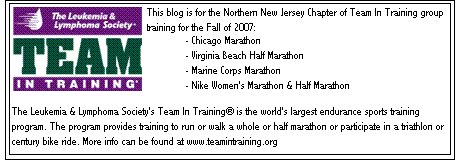 I was out running with a number of people in Liberty State Park today, and one of the runners said to me that her breathing had gotten a little easier over the last few weeks. This makes common sense, but actually makes a good introduction to the two major principles of endurance training.
I was out running with a number of people in Liberty State Park today, and one of the runners said to me that her breathing had gotten a little easier over the last few weeks. This makes common sense, but actually makes a good introduction to the two major principles of endurance training.Overload
Overload means exercising at a level which causes the body to adapt to function more efficiently. It doesn't mean overtraining. Think of a rubberband - as more pull is applied it stretches more and becomes easier to stretch, but too much pull can cause it to snap. To avoid breaking, i.e., becoming injured or ill, overload must always be used in conjunction with rest. Overload and rest form the basis for what is known as the "hard/easy" training approach. This technique uses variations in frequency, intensity and duration to achieve cycles of overload and rest. Frequency is how often you run, intensity is the pace at which the workout is conducted and duration is the time spent on any single run. In a program of increasing mileage or of building basic endurance, "hard" may be a long slow run while "easy" may be a shorter distance run at the same effort. For the experienced runner with an established mileage base, "hard" might be a shorter workout of increased intensity such as hill work, fartlek or some kind of interval training. After a hard workout, rest or an easy workout is important because it allows the muscles and other tissues a chance to rebuild and adapt to the stress. This is the basis of overload training.
Specificity
Specificity refers to adaptations of both metabolic and physiologic systems, depending on the type of overload used. Specific exercise brings about changes in those systems used in that particular exercise. Running is obviously the specific training for running. Different adaptations result from different kinds of running using variations of frequency, intensity, duration and terrain to utilize different sources of energy. This is where long term goal setting is so important: you need a running program designed for the specific type of races you want to run. This approach will assist you to maximize performance and eliminate wasted effort. Specific endurance training with its resultant physiologic adaptations is essential for marathons.
So much of your body is adaptable.... i.e. trainable.... but different systems adapt at different rates....... your circulatory system, pulmonary and neuromuscular systems may well start adapting in 4-6 weeks of training.... meaning you will be increasing your blood volume, strenghtening your heart muscle, lowering your heart rate, improving your lung volume, reducing fatigue and creating new muscle pathways.... but your skeletal system tends to lag behind in adaption, and improve only aftert 6-8 weeks of training.
As a result, we often find athletes feeling great and pushing themselves to new limits four weeks in, and then breaking down with stress fractures, and hurting joints midseason.
So..... the key is to increase your mileage slowly.... no more than 10% total miles increase each week, to allow your body to adapt fairly evenly.
"Jogging is very beneficial. It's good for your legs and your feet. It's also very good for the ground. It makes it feel needed." ~Charles Schulz, Peanuts
Have a great week.
Coach David
article thanks to Warren and Patti Finke @ Team Orgegan for the article.



No comments:
Post a Comment